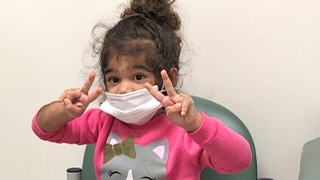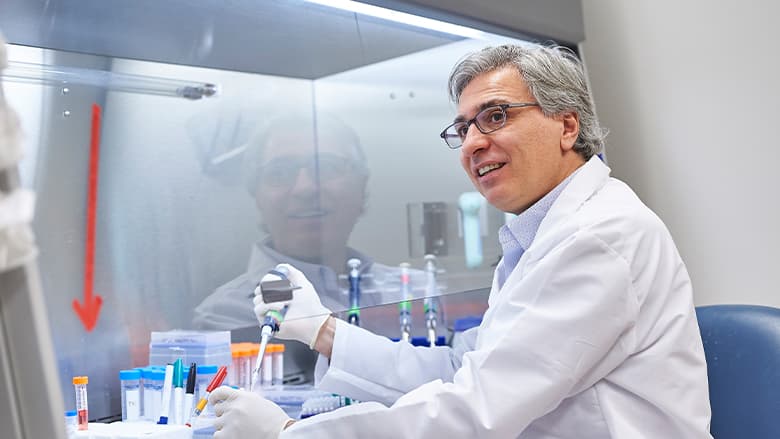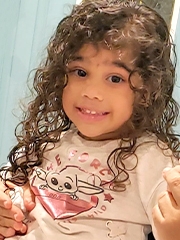Insulinoma: Leilani’s story
Published on
Published on
As Maria watched her 2-year-old daughter, Leilani, go from an active, happy toddler to an exhausted, fussy child, she knew something was not right — despite several doctors near their Tampa, Fla.-area home telling her everything was fine.
 It took Maria’s relentless effort to find a diagnosis and persistence on dad Anthony’s part to get insurers on board so that Leilani could be cured at Children’s Hospital of Philadelphia (CHOP).
It took Maria’s relentless effort to find a diagnosis and persistence on dad Anthony’s part to get insurers on board so that Leilani could be cured at Children’s Hospital of Philadelphia (CHOP).
Early in 2020, Leilani started sleeping for as long as 18 hours straight and had bouts of shaking uncontrollably and staring blankly into space, which lead to several trips to the pediatrician’s office and emergency room. Each time, the family was told she was just tired and there was nothing to worry about.
Then one morning in March 2020, Maria could not wake her up. “She was totally unresponsive, limp,” Maria says. “I was so scared.”
She called an ambulance. The paramedics checked Leilani’s blood sugar level for the first time. It came back at a dangerously low 14 mg/dL. Normal levels for a 2-year-old are 70 to 100 mg/dL.
Her low blood sugar, or hypoglycemia, explained Leilani’s sleepiness, shaking and staring, but what was the cause of the lows? Doctors in Florida couldn’t figure it out.
“She kept getting worse and worse,” says Anthony. “We took her four or five times to the hospital, and they still had no clue.”
At one point Leilani was diagnosed, incorrectly, with glycogen storage disease. Not unsurprisingly, the treatments didn’t help. Leilani was too exhausted to play. Then she pretty much stopped eating and needed a feeding tube inserted into her belly. Maria was checking her blood sugars a couple of times an hour, and they were generally low, but there would be some higher readings, too.
Maria became a sleuth. “It was a puzzle,” she says. “I started researching and reading everything I could find.” When she read about insulinomas, small, benign tumors in the pancreas that produce excess insulin that lower blood sugars, something clicked. “I asked her endocrinologist: ‘Could it be an insulinoma?’”

Philanthropy-fueled research ensures a healthy future for children like Leilani.
Insulinomas are extremely rare overall — 1 in 250,000 people a year — and nearly nonexistent in children.
The local endocrinologist thought Maria could be right. But no hospital in Florida is equipped to perform the type of test on a child that could located where within the pancreas the tumor might be hiding. “They told us they would have to take out 95% of her pancreas and hope the insulinoma was in the part they removed,” Anthony says. A near-total pancreatectomy would mean she could no longer produce enough insulin and would develop diabetes as she grew.
Maria’s research had led her to N. Scott Adzick, MD, MMM, CHOP’s Surgeon-in-Chief, who has performed more pancreatectomies on children than any other surgeon in the world: more than 550.
Their local doctors pushed for Leilani to come to Philadelphia, but the insurer wouldn’t approve it. COVID-19 didn’t help matters. In September, the insurer said OK. The family was on its way to Pennsylvania when the insurer cancelled its approval. “We were in North Carolina and had to turn around and go home,” Anthony says. “It was awful.”
On CHOP’s end, nurse coordinator Nicole Stewart, BSN, RN, continued to make the case to the insurer that CHOP was the best place for Leilani to have surgery.
“She did everything she could to facilitate our coming to CHOP,” Maria says.
Finally, in December, the insurance company green-lighted the transfer. They arrived Dec. 7.
The doctors and nurses in CHOP’s Congenital Hyperinsulinism (HI) Center are experts in managing children with severely low blood sugar as it is the main symptom of HI. They put that experience to use with Leilani. They were able to wean her off all the medications she had been on, controlling her hypoglycemia with dextrose (sugar water) through her feeding tube. The insulinoma was so small, 1 cm, she needed a PET scan and an MRI to locate it.
On Christmas Eve, Dr. Adzick performed a partial pancreatectomy, taking out 40% of Leilani’s pancreas to ensure the tumor was removed. (The remaining portion will be able to produce enough insulin to prevent her from developing diabetes.) Leilani is the youngest insulinoma patient he has operated on.
She was still recovering when she turned 3 on Dec. 26. A few days later, Leilani passed a fasting test, proving she had been cured.
 “She’s like a new kid since we got home,” Maria says. “She’s running around and playing all day. She’s making up for all that lost time.”
“She’s like a new kid since we got home,” Maria says. “She’s running around and playing all day. She’s making up for all that lost time.”
Her favorite activities are painting and drawing, playing hide and seek, and annoying her brothers Joey and Johnny.
“Leilani is proof that you have to go to the hospital where the specialization is,” Anthony says. “CHOP’s hyperinsulinism team and Dr. Adzick are the experts. Nothing was helping Leilani until we got to CHOP.”
Maria says, “And now she’s cured. We’re forever grateful.”